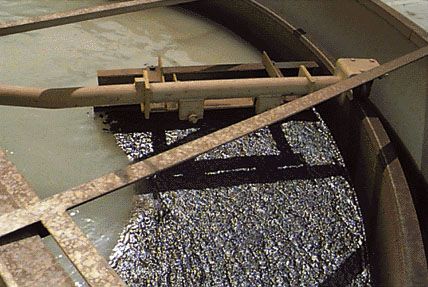Superfund's Plodding Cleanup
OCT. 7, 2010
GAO Report Questions EPA’s Ability to Finance Toxic Cleanups in a Timely Manner
By J.T. LONG
After 30 years and an estimated $33 billion spent to clean up toxic waste sites, taxpayers still have a mess on their hands, according to a June Government Accountability Office report on the U.S. Environmental Protection Agency Superfund program.
The program was established in 1980 in reaction to the discovery that a toxic waste dump site had been buried in what was known as the Love Canal by Hooker Chemical Co. More than 100 homes and a school had subsequently been built over the top of the makeshift disposal site. In 1978, a record rainfall in the Niagra Falls area caused chemicals to begin leaching into backyards, killing landscaping, fouling the air and burning skin. A wave of miscarriages and birth defects followed. So did the Comprehensive Environmental Response, Compensation and Liability Act of 1980.
Since then, 47,000 hazardous waste sites have been identified. More than 1,000 of most seriously contaminated sites were put on the National Priorities List because they posed “relatively high risks to human health.” These sites contained materials such as lead and polychlorinated biphenyl, which can cause birth defects, cancer and development disorders.
Removing hazardous waste, particularly if it has entered the groundwater can be a lengthy process. At the end of 2009 of the 1,111 non-federal sites listed on the list, 695 had reached what the EPA calls “construction complete, meaning that the immediate risks had been addressed and long-term risks were “under control”, but operation and maintenance often continued.
A total of 75 non-federal sites were considered to have “unacceptable human exposure risk” with more than half of the work remaining to complete remedial construction, according to the GAO report titled “Superfund: EPA’s Costs to Remediate Existing and Future Sites Will Likely Exceed Current Funding Levels.” The reference to future sites refers to places already identified with unknown human exposure that could be added to the list. The GAO report predicted that the number of sites added to the list over the next five years will be greater than the number listed in the past five years. “EPA regional officials estimate that from 101 to 125 sites — an average of 20 to 25 sites per year — will be added to the NPL over the next 5 years.” Five of those could come from California where the state doesn’t have funds to manage cleanup on the sites already identified.
Funding Limits Effectiveness
The Hazardous Substance Superfund trust fund was financed largely by taxes on crude oil and corporations until that taxing authority ran out in 1995. Since 2001, general fund revenues in the order of $1.2 billion annually have funded the program. During that time, a 2008 GAO report titled “Superfund Funding and Costs” estimated that fines penalties and recoveries contributed 19 percent of trust fund revenues. The EPA Office of Enforcement and Compliance Assurance is tasked with identifying responsible parties past and present and “compelling them” to pay for clean up. Absent a responsible party that can afford the remediation, the EPA steps in as a health and safety measure. The 2010 report questioned whether this funding method is resulting in the best clean up possible.
John B. Stephenson, director of Natural Resources and Environment testified that “despite the relatively high level of expenditures at sites with unacceptable human exposure… construction has not been conducted in the most timely and cost-efficient manner because the EPA had to balance limited annual resources among various program activities.”
To conduct remedial construction in the most efficient manner at 142 of the non-federal NPL sites for fiscal years 2010 through 2014 would range form $335 million to $681 million. The report acknowledged that estimates might be understated as costs were not available for 57 sites and surprises often increase the price of a project.
EPA headquarters determines the amount of resources that the Superfund program will allocate to the regions by using a model that distributes available funding based on a combination of historical allocations and a work-based scoring system that scores each region based on projects planned for the upcoming year.
EPA officials told GAO reporters that their regions currently receive about half or less than half of the funding they could use for pre-construction activities. As a result, most regions have sites that have experienced delays in the pre-construction phase because of insufficient funding. Similarly, sites with ongoing construction have experienced delays caused by limited funding, according to EPA officials. Since fiscal year 2000, most regions have experienced delays because of insufficient funding at one or more sites with ongoing construction. Delays increase the length of time it takes to clean up a site, total cleanup costs and, in some cases, the length of time populations are exposed to contaminants.
Work that would not have been funded otherwise was jump started in 2009 at 25 sites with help from $582 million in American Recovery and Reinvestment Act funds. But much work remains.
California Contamination
In California, the five sites that could “continue to pose human risk” after 2010 stem from abandoned mines or former chemical plants leaking heavy metals and minerals such as arsenic into ground and surface water.
One example is the Lava Cap Mine in the foothills community of Nevada County, where an estimated 1,776 people living within a mile of the site and visitors in the recreational area are exposed to possible ingestion of arsenic in the soil, inhalation of contaminated airborne particles and skin contact with contaminated sediments.
The abandoned mine dates back to 1861 and at one time was one of the largest gold mines operating in California, producing approximately 300-400 tons of ore a day. It was placed on the Superfund National Priorities List in January 1999. Remediation has so far included relocating two households, distributing temporary drinking water filter units and initiation of land-use restrictions. More than 4,000 cubic yards of tailings were removed, stream diversions were created, a failed log dam was replaces with a rock buttress and a lined clay cap installed. A final report on cleanup alternatives for the Lost Lake area downstream where fish are being impacted is expected in Spring of 2011, according to EPA Region 9 communications coordinator Rusty Harris-Bishop.
The total bill for remediation is expected to run about $50 million. In a court-ordered settlement, Canadian-based Newmont Mining Corp, which owned the mine from 1983 to 1986 with unrealized plans to reopen the operation, agreed to pay $3 million toward cleanup costs. Two other lawsuits are pending, but remediation is moving forward in the meantime. The EPA estimates human exposure will be controlled at Lost Lake by 2013. Then the groundwater will be addressed with completion of remedial action there slated for 2016. Addressing the problem in phases has been a logical approach, according to Harris-Bishop. “We have to address the creek discharge before we can assess the extent of the groundwater contamination,” he said. “Once the construction of the remediation technology is in place, it could be there forever.”
Related Articles
PG&E Chapter 11 moves ahead – despite criticism over bonuses and board
Pacific Gas & Electric’s decision to file for Chapter 11 bankruptcy in January – coming after three years of deadly,
After rash of overdoses, Senate advances bill to punish Fentanyl traffickers
A Senate panel unanimously advanced a bill on Tuesday that would significantly increase the penalties for possession of large quantities
Bring Out the Budget Scissors
MARCH 31, 2011 By JOHN SEILER The voters have spoken: Cut the budget even more. Gov. Jerry Brown and Democrats





